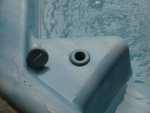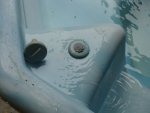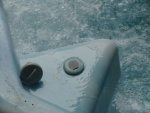- Aug 7, 2009
- 220
Brand new to the forum just today. I'm thoroughly impressed by the knowledge here...I've been poking around for a couple weeks now, and have realized a lot of my mistakes/missed opportunities. This is my second season of being a pool owner, and have enjoyed 99% of it. Thanks for everything everyone does here.
Inground Heldor spa (circa 1990?) had been disconnected completely from a support system for probably 10 years. Found just 2 pipes sticking out of the ground. Hot tub guy came out, chopped off all of the exposed plumbing to the pool (needed replacement anyway), and plumbed it in altogether, to take advantage of the good gas heat. Now, I have 6 valves (3 suction, 3 return). Has been great, and enjoyable for the past 2 weeks. Couple issues, though.
I lose about .5-1" of water daily. Tub is set in concrete, so I can't see any water leakage. No puddling in yard either.
Air intake port (top of tub) fills up w/water. Obviously, no air is entering to allow air adjustment.
Pool guy seems to think I have leaky jets. So, would A) leaky jets cause the tub to lose this much water, B) leaky jets cause the air intake to fill up, and C) at some point burn up my blower? The blower is the same vintage Mariah 120v, and actually surprised it worked when we fired it up. The good thing is is that the jets have the 2 pinholes in them, which I'm assuming means a tool will allow it to be unthreaded, and retro-fitted.
I have no documentation as to why this tub was chopped off. All I know is that the previous owners replaced all of the equipment during their stay, and did not use the tub often. I also do not know if a common support system set-up was used or not.
Greg
Inground Heldor spa (circa 1990?) had been disconnected completely from a support system for probably 10 years. Found just 2 pipes sticking out of the ground. Hot tub guy came out, chopped off all of the exposed plumbing to the pool (needed replacement anyway), and plumbed it in altogether, to take advantage of the good gas heat. Now, I have 6 valves (3 suction, 3 return). Has been great, and enjoyable for the past 2 weeks. Couple issues, though.
I lose about .5-1" of water daily. Tub is set in concrete, so I can't see any water leakage. No puddling in yard either.
Air intake port (top of tub) fills up w/water. Obviously, no air is entering to allow air adjustment.
Pool guy seems to think I have leaky jets. So, would A) leaky jets cause the tub to lose this much water, B) leaky jets cause the air intake to fill up, and C) at some point burn up my blower? The blower is the same vintage Mariah 120v, and actually surprised it worked when we fired it up. The good thing is is that the jets have the 2 pinholes in them, which I'm assuming means a tool will allow it to be unthreaded, and retro-fitted.
I have no documentation as to why this tub was chopped off. All I know is that the previous owners replaced all of the equipment during their stay, and did not use the tub often. I also do not know if a common support system set-up was used or not.
Greg




